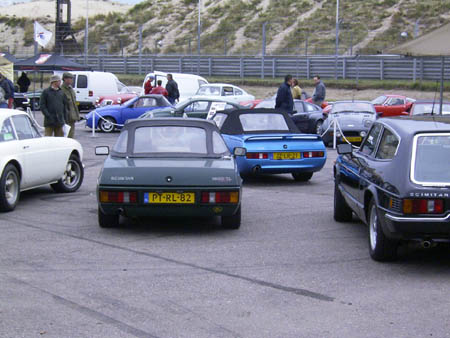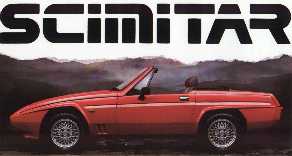

Three
models for the price of one? These three are in one chapter, because
the basicly the same. The SS1 is the 1983-1990 age; SST 1990 and the
Scimitar Sabre 1992-1995.
All cars share (almost) the same chassis. SS1 has the all seperate bodywork,
with all bad fittings that may come from that. The SST and Scimitar
Sabre have a one piece body. Much smoother than an SS1. But the SST
is rather plain to me. The Scimitar Sabre has the looks the car should
have had in the first place.
The SS1 is possibly the most underrated sportscar in the scene.
Where do you find so much value for money in a sportscar? The current
prices are low, you can still find a decent SS1 1800ti for < £
3000 / EUR 4500. But a real good car will do double. And for that amount
of money you drive an open twoseater with a topspeed above 120 MpH /
200 KmH. Then add a real good roadbehaviour and low running cost to
it and it is the best you can buy.
A bit too optimistic you think? Well, all of the above is true, but
I admit, an SS1 needs some getting used to. And the interior looks plain,
the dashboard is almost standard Austin Metro. Not a good choise. On
the other hand you have a choise of models, from 1300cc, 1400cc, 1600cc
Ford engines and a 1800cc Nissan turbo engine. The SS1 was made in both
RHD as LHD.It offers a decent luggage space for the type of car. This
might be the sportscar you were looking for.
 What about the choise of engines? Start at the smallest version of
the Ford engines, the 1300cc. It will get you from A to B, but not in
a true sportscar way. The same goes for the 1400cc. These engines are
too underpowered for the car.In fact it is the same engine as in the
family Escort. Another downside is the 4 speed gearbox. And some cars
had a hard live if a previous owner mistook a 13/1400 for a faster model.
What about the choise of engines? Start at the smallest version of
the Ford engines, the 1300cc. It will get you from A to B, but not in
a true sportscar way. The same goes for the 1400cc. These engines are
too underpowered for the car.In fact it is the same engine as in the
family Escort. Another downside is the 4 speed gearbox. And some cars
had a hard live if a previous owner mistook a 13/1400 for a faster model.
A Ford 1600cc version is much better, these cars also have a 5 speed
gearbox. This engine suits the car better. This is the Escort XR3 or
Fiesta XR2 engine, the carburetor version. A 1600 is a rather good compomise
between a high speed sportscar and a boulevard cruiser. It won't let
you down driven fast, but the chassis never reaches the point of no
return. And if you go for an exchange scheme like Specialized Engines
offer: Big for Small, trading the 1600 for a 1900 cc. This gives you
a fast car without turbo trouble.
And then you have the Nissan 1800cc turbo.... it exactly that what the
SS1 makes a great sportscar. The upside is also the downside: The turbo
is very fast and most of them are driven that way. Beware of tired turbos
unless you want to spend a lot of money. A strange thing about these
fast cars are the brakes. In the British press these have been considered
good, but in Germany considered underrated.Some German cars have an
uprated system with Porsche brake parts This was designed by a German
enthousias, who works for Porsche. (He drives Porsches for a living,
but his private car remains a 1800 ti.) But also in Britain some people
complained about the brakes and made a conversion. An interesting story
about brakes is available on Scimweb, under stories.
What can you expect from the SS1? In short- A great driving car
with some nasty weak spots First: The chassis. This can rot badly, but
all chassisnr. > ----900 cars have a galvanised chassis. A pre-900
chassis should be inspected carefully. But do not think evertything
is rust-free on a >900 car. I've seen severe rust on '95 Scimitar
Sabre windowframes.
Another bad thing can be the electrics. Still (much) better than on
a GTE. It can work perfectly so why buy a car with strange wirings.
Sometimes the headlight lifters have a live of their own.One or maybe
even both won't come down anymore, but the cure is easy: cleaning the
contacts. The powerwindows can stick.
Really beware of torn upper front suspension arms. Check these with
the wheel removed and look at the joint to the chassis. No cracks allowed.
Re-inforced replacements are widely available.
The
Ford engines have the same things as standard Escorts, so no real surpises
here. The Nissan engines have one or two nasty habbits. This engine
does not last as long as the normal Nissan pertol engine.
Reason: having a hard life without proper maintenance. Turbo's will
be gone after 150,000 km, like the engine itself. Most high milage cars
will be refitted with a new engine. I know my previous 1800ti has one
and my current has a replacement twinspark.
A real nasty habbit is blowing the gaskets around the turbo. You know
it happened when the engine starts making a lot of noise accelerating.
Some loss of power will occur. The trouble is not the gaskets, any Scimitar
or Nissan dealer can provide these. The trouble is the amount of work.
Replacing means dismantling the exhaust and turbo and lifting the engine
at least 10 cm. A lot of work, and not so suitable for the average home
mechanic.
SS1's were produced from 1984, launched Motor Show at the NEC,
until februari 1990, a total made of only 1504 cars. Most
cars were sold in the UK, with Germany as runner up. Other markets were
Switserland and the Netherlands. The first year it was rather successfull:
 |
1984 | - | 25 produced |
| 1985 | - | 705 produced | |
| 1986 | - | 264 produced | |
| 1987 | - | 237 produced | |
| 1988 | - | 187 produced | |
| 1989 | - | 91 produced (incl. 1990) |
But after just one year nobody seemed to want one. And the later cars are much more value for money, from chassis# 900 on the chassis were galvanised. This makes an SS1 virtually indestrucable. And also from chassis # 900 on LHD versions were built (though I know at least one LHD car with a lower number!). Looking at the sales figures, most 1987-onwards cars must have been LHD's.And from the ads in Slice; lots of pre-1987, but hardly later cars. A lot of German sold cars are / have been in the hands of non-RSSOC members. But a lot of owners are/were RSOCG-member cars (former German club).
The most unloved sportscar, what a cross to bear for a car. But if you have ever driven one, you know all the others were wrong.